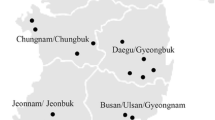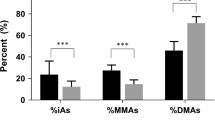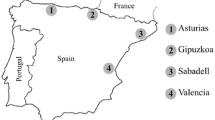Abstract
More than 0.3 million individuals are subject to chronic exposure to arsenic via their drinking water in Inner Mongolia, China. To determine arsenic methylation capacity profiles for such individuals, concentrations of urinary arsenic metabolites were measured for 548 subjects using high-performance liquid chromatography and a hydride generator combined with inductively coupled plasma-mass spectrometry. Mean urinary concentrations of dimethylarsonic acid (DMA), monomethylarsonic acid (MMA), inorganic arsenic (iAs), and total arsenic (TAs) were 200.50, 46.71, 52.96, and 300.17 μg/L, respectively. The %iAs, %DMA, and %MMA were 15.98, 69.72, and 14.29 %. Mean urinary %iAs and %MMA were higher in males, while urinary %DMA was higher in females. There was a strong positive correlation between %iAs and %MMA, with negative correlations between %iAs and %DMA, and %iAs and %MMA. In addition, %iAs and %MMA were positively associated with total arsenic in drinking water (WAs), while %DMA was negatively related with WAs. Regression analysis indicated that the primary methylation index (PMI) and secondary methylation index (SMI) generally decreased with increasing WAs. Females had a higher arsenic methylation capacity compared to males. Younger subjects had lower primary arsenic methylation capacity. However, the secondary arsenic methylation capacity was hardly affected by age. Moreover, both primary and secondary arsenic methylation capacities were negatively related to WAs.



Similar content being viewed by others
References
Kile M, Hoffman E, Rodrigues EG et al (2011) A pathway-based analysis of urinary arsenic metabolites and skin lesions. Am J Epidemiol 173:778–786
WHO (World Health Organization) (2001) Arsenic and arsenic compounds. EHC 224. International Programme on Chemical Safety, WHO, Geneva
IARC (International Agency for Research on Cancer) (2004) Arsenic in drinking water. IARC Monogr Eval Carcinog Risks Hum 84:39–267
Rahman A, Vahter M, Ekström EC et al (2007) Association of arsenic exposure during pregnancy with fetal loss and infant death: a cohort study in Bangladesh. Am J Epidemiol 165:1389–1396
Balakumar P, Kaur J (2009) Arsenic exposure and cardiovascular disorders: an overview. Cardiovasc Toxicol 9:169–176
Chung C, Hsueh Y, Bai C et al (2009) Polymorphisms in arsenic metabolism genes, urinary arsenic methylation profile and cancer. Cancer Causes Control 20:1653–1661
Liu SN, Zhang L, Sun QS et al (2015) The distribution in tissues and urine of arsenic metabolites after subchronic exposure to dimethylarsinic acid (DMA(V)) in rats. Biol Trace Elem Res 156:12–21
Seow WJ, Pan WC, Kile ML et al (2012) Arsenic reduction in drinking water and improvement in skin lesions: a follow-up study in Bangladesh. Environ Health Perspect 20:1733–1738
Bhattacharjee P, Banerjee M, Giri AK (2013) Role of genomic in stability in arsenic induced carcinogenicity: a review. Environ Int 53:29–40
Li X, Li B, Xi S et al (2013) Association of urinary monomethylated arsenic concentration and risk of hypertension: a cross-sectional study from arsenic contaminated areas in northwestern China. Environ Health 12:1–10
Pan WC, Seow WJ, Kile ML et al (2013) Association of low to moderate levels of arsenic exposure with risk of type 2 diabetes in Bangladesh. Am J Epidemiol 178:1563–1570
Zhang Q, Wang D, Zheng Q et al (2014) Joint effects of urinary arsenic methylation capacity with potential modifiers on arsenicosis: across-sectional study from an endemic arsenism area in Huhhot Basin, northern China. Environ Res 132:281–289
WHO (2003) Arsenic in drinking-water. Background document for preparation of WHO Guidelines for Drinking-Water Quality. World Health Organization, Geneva
Shraim A, Sekaran NC, Anuradha CD et al (2002) Speciation of arsenic in tube-well water samples collected from West Bengal, India, by high-performance liquid chromatography-inductively coupled plasma mass spectrometry. Appl Organomet Chem 16:202–209
Chen Y, Wu F, Graziano JH et al (2013) Arsenic exposure from drinking water, arsenic methylation capacity, and carotid intima-media thickness in Bangladesh. Am J Epidemiol 178:372–381
Vahter M (2002) Mechanisms of arsenic biotransformation. Toxicology 181–182:211–217
Thomas DJ, Waters SB, Styblo M (2004) Elucidating the pathway for arsenic methylation. Toxicol Appl Pharmacol 198:319–326
Huang YK, Tseng CH, Huang YL et al (2007) Arsenic methylation capability and hypertension risk in subjects living in arseniasis-hyperendemic areas in southwestern Taiwan. Toxicol Appl Pharmacol 218:135–142
Hsieh RL, Huang YL, Shiue HS et al (2014) Arsenic methylation capacity and developmental delay in preschool children in Taiwan. Int J Hyg Environ Health 217:678–686
Sun G, Xu Y, Li X et al (2007) Urinary arsenic metabolites in children and adults exposed to arsenic in drinking water in Inner Mongolia, China. Environ Health Perspect 115:48–652
Huang Y, Hsueh Y, Huang Y et al (2009) Urinary arsenic methylation capability and carotid atherosclerosis risk in subjects living in arsenicosis-hyperendemic areas in southwestern Taiwan. Sci Total Environ 407:2608–2614
Agusa T, Trang PTK, Lan VM et al (2014) Human exposure to arsenic from drinking water in Vietnam. Sci Total Environ 488–489:562–569
De Castro BR, Caldwell KL, Jones RL et al (2014) Dietary sources of methylated arsenic species in urine of the United States population, NHANES 2003–2010. PLoS One 9(9):1–12
Kitchin KT (2001) Recent advances in arsenic carcinogenesis: modes of action, animal model systems, and methylated arsenic metabolites. Toxicol Appl Pharmacol 172:249–261
Styblo M, Drobna Z, Jaspers I et al (2002) The role of biomethylation in toxicity and carcinogenicity of arsenic: a research update. Environ Health Perspect 110:767–771
Li X, Li B, Xu Y et al (2011) Arsenic methylation capacity and its correlation with skin lesions induced by contaminated drinking water consumption in residents of chronic arsenicosis area. Environ Toxicol 26:118–123
Xi S, Zheng Q, Zhang Q et al (2011) Metabolic profile and assessment of occupational arsenic exposure in copper and steel smelting workers in China. Int Arch Occup Environ Health 84:347–353
Huang YK, Huang YL, Hsueh YM et al (2008) Arsenic exposure, urinary arsenic speciation, and the incidence of urothelial carcinoma: a twelve-year follow-up study. Cancer Causes Control 19:829–839
Steinmaus C, Yuan Y, Kalman D et al (2010) Individual differences in arsenic metabolism and lung cancer in a case–control study in Cordoba, Argentina. Toxicol Appl Pharmacol 247:138–145
Lindberg AL, Kumar R, Goessler W et al (2007) Metabolism of low-dose inorganic arsenic in a central European population: influence of sex and genetic polymorphisms. Environ Health Perspect 115:1081–1086
Yu RC, Hsu KH, Chen CJ et al (2000) Arsenic methylation capacity and skin cancer. Cancer Epidemiol Biomarkers Prev 9:1259–1262
Chen YC, Su H, Guo YL et al (2005) Interaction between environmental tobacco smoke and arsenic methylation ability on the risk of bladder cancer. Cancer Causes Control 16:75–81
Steinmaus C, Bates MN, Yuan Y et al (2006) Arsenic methylation and bladder cancer risk in case–control studies in Argentina and the United States. J Occup Environ Med 48:478–488
Pu YS, Yang SM, Huang YK et al (2007) Urinary arsenic profile affects the risk of urothelial carcinoma even at low arsenic exposure. Toxicol Appl Pharmacol 218:99–106
Guo X, Fujino Y, Kaneko S et al (2001) Arsenic contamination of groundwater and prevalence of arsenical dermatosis in the Hetao plain area, Inner Mongolia, China. Mol Cell Biochem 222:137–140
Deng Y, Wang Y, Ma T et al (2009) Speciation and enrichment of arsenic in strongly reducing shallow aquifers at western Hetao Plain, northern China. Environ Geol 56:1467–1477
Gamble MV, Liu X, Ahsan H et al (2005) Folate, homocysteine, and arsenic metabolism in arsenic-exposed individuals in Bangladesh. Environ Health Perspect 113:1683–1688
Saoudi A, Zeghnoun A, Bidondo M et al (2012) Urinary arsenic levels in the French adult population: the French National Nutrition and Health Study, 2006–2007. Sci Total Environ 433:206–215
Agusa T, Kunito T, Minh TB et al (2009) Relationship of urinary arsenic metabolites to intake estimates in residents of the Red River Delta, Vietnam. Environ Pollut 157:396–403
Hsueh YM, Ko YF, Huang YK et al (2003) Determinants of inorganic arsenic methylation capability among residents of the Lanyang Basin, Taiwan: arsenic and selenium exposure and alcohol consumption. Toxicol Lett 137:49–63
Francesconi KA, Kuehnelt D (2004) Determination of arsenic species: a critical review of methods and applications, 2000–2003. Analyst 129:373–395
Ahsan H, Chen Y, Kibriya MG et al (2007) Arsenic metabolism, genetic susceptibility, and risk of premalignant skin lesions in Bangladesh. Cancer Epidemiol Biomarkers Prev 16:1270–1278
Steinmaus C, Moore LE, Shipp M et al (2007) Genetic polymorphisms in MTHFR 677 and 1298, GSTM1 and T1, and metabolism of arsenic. J Toxicol Environ Health A 70:159–170
Tseng CH (2007) Arsenic methylation, urinary arsenic metabolites and human diseases: current perspective. J Environ Sci Health C Environ Carcinog Ecotoxicol Rev 25:11–22
Lindberga AL, Ekstro EC, Nermell B et al (2008) Gender and age differences in the metabolism of inorganic arsenic in a highly exposed population in Bangladesh. Environ Res 106:110–120
Fu S, Wu J, Li Y et al (2014) Urinary arsenic metabolism in a Western Chinese population exposed to high-dose inorganic arsenic in drinking water: influence of ethnicity and genetic polymorphisms. Toxicol Appl Pharmacol 274:117–123
Xi S, Sun Q, Wang F et al (2014) The factors influencing urinary arsenic excretion and metabolism of workers in steel and iron smelting foundry. J Expo Sci Environ Epidemiol 24:36–41
Del Razo LM, Garca-Vargas GG, Vargas H et al (1997) Altered profile of urinary arsenic metabolites in adults with chronic arsenicism: a pilot study. Arch Toxicol 71:211–217
Acknowledgments
The work described in this paper was financially supported by the State Key Program of National Natural Science of China (Grant No. 41230749) and the National Public Welfare Sectors (Agriculture) special research fund (Project No. 201203012-6).
Conflict of Interest
The authors declare they have no competing financial interests.
Author information
Authors and Affiliations
Corresponding author
Rights and permissions
About this article
Cite this article
Wei, B., Yu, J., Li, H. et al. Arsenic Metabolites and Methylation Capacity Among Individuals Living in a Rural Area with Endemic Arseniasis in Inner Mongolia, China. Biol Trace Elem Res 170, 300–308 (2016). https://doi.org/10.1007/s12011-015-0490-5
Received:
Accepted:
Published:
Issue Date:
DOI: https://doi.org/10.1007/s12011-015-0490-5




